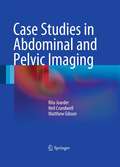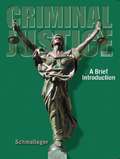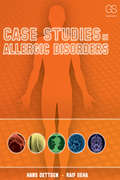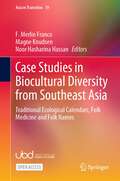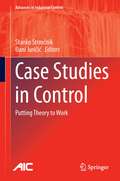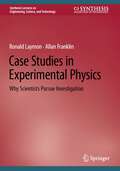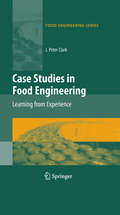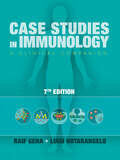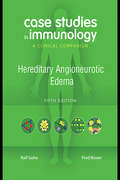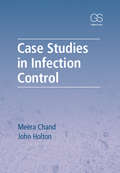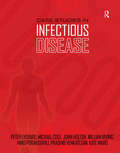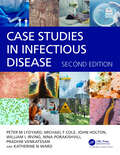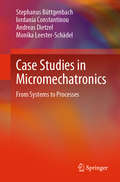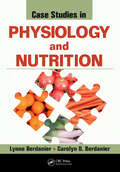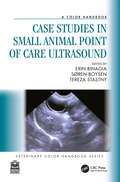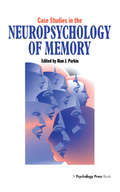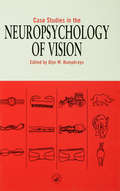- Table View
- List View
Case Studies in Abdominal and Pelvic Imaging
by Rita Joarder Matthew Gibson Neil CrundwellCase Studies in Abdominal and Pelvic Imaging presents 100 case studies, covering both common every-day conditions of the abdomen and pelvis, as well as less common cases that junior doctors and radiologists in training should be aware of. Compiled by experts in the field, Case Studies in Abdominal and Pelvic Imaging uses the most up-to-date and high quality images, including plain films, CT scans, MRI scans and the occasional nuclear medicine image where relevant. Each case is presented in a pedagogical style, with 1-4 images and accompanying questions, followed by answers and further relevant images. This is then augmented by an explanation of the imaging and key teaching points with references for further reading, making this book a valuable learning guide in an accessible form.
Case Studies in Abnormal Behavior
by Frank SchmallegerTopics discussed: anxiety disorders, sleep disorders, sexual disorders, delusional disorders, depression, substance abuse, violence, eating disorders, among others.
Case Studies in Allergic Disorders
by Raif Geha Hans OettgenCase Studies in Allergic Disorders is designed for undergraduate and graduate students in immunology, medical students, and resident physicians. It describes the basic cellular and molecular mechanisms involved in the pathogenesis of commonly occurring allergic diseases and introduces the rationale for targeted treatment of allergy. Replicating the successful approach of Case Studies in Immunology, the book presents mechanisms of hypersensitivity through a selection of clinical cases that reinforce and extend the basic science. The cases are largely drawn from the records of Children‘s Hospital Boston. Linking the discussion of pathogenesis to actual clinical presentation establishes important connections between the bench and bedside. The book can be used as either a stand-alone text or asa companion to Janeway‘s Immunobiology and The Immune System.
Case Studies in Biocultural Diversity from Southeast Asia: Traditional Ecological Calendars, Folk Medicine and Folk Names (Asia in Transition #19)
by Noor Hasharina Hassan F. Merlin Franco Magne KnudsenThis open access book demonstrates the linkages between local languages, traditional knowledge, and biodiversity at the landscape level in Asia, providing a fresh approach to discussions on Asia’s biocultural diversity. The book carries forward earlier analyses but importantly focuses on ‘traditional ecological calendars,’ ‘folk medicine,’ and ‘folk names’ in the context of the vital importance of maintaining biological, cultural, and linguistic diversity. It does this by addressing a range of cases and issues in relation to Southeast Asia: Brunei Darussalam, Indonesia, Malaysia, the Philippines, and North-East India. The several chapters demonstrate the ways in which the various forms of knowledge of the environment and its categorizations are important in areas such as landscape and resource management and conservation. They also demonstrate that environmental knowledge and the practical skills which accompany it are not necessarily widely shared. This book sends important messages to those who care about the sustainability of our environment, the maintenance of its biocultural diversity, or at least the maintenance of what remains of it because much has changed. This interdisciplinary collection draws from a wide range of disciplines and is of appeal to students and scholars in anthropology, environmental studies, geography, biodiversity, and linguistics.
Case Studies in Chest Imaging
by Rita Joarder Neil CrundwellCase Studies in Chest Imaging is a collection of 100 real cases, which demonstrate the use of modern imaging techniques and illustrate the appropriate use of imaging in the investigation of pathology. Compiled by experts in the field, Case Studies in Chest Imaging uses the most up-to-date and high quality images, including plain films, standard Multi Slice and High Resolution Thoracic CT scans. Each case is presented in a pedagogical style, with 1-4 images and accompanying questions, followed by answers and further relevant images. This is then augmented by an explanation of the imaging and key teaching points with references for further reading, making this book a valuable learning guide in an accessible form for respiratory and acute physicians, and radiologists in training.
Case Studies in Control: Putting Theory to Work (Advances in Industrial Control)
by Stanko Strmčnik Đani JuričićCase Studies in Control presents a framework to facilitate the use of advanced control concepts in real systems based on two decades of research and over 150 successful applications for industrial end-users from various backgrounds. In successive parts the text approaches the problem of putting the theory to work from both ends, theoretical and practical. The first part begins with a stress on solid control theory and the shaping of that theory to solve particular instances of practical problems. It emphasizes the need to establish by experiment whether a model-derived solution will perform properly in reality. The second part focuses on real industrial applications based on the needs and requirements of end-users. Here, the engineering approach is dominant but with theoretical input of varying degree depending on the particular process involved. Following the illustrations of the progress that can be made from either extreme of the well-known theory-practice divide, the text proceeds to a third part related to the development of tools that enable simpler use of advanced methods, a need only partially met by available commercial products. Each case study represents a self-contained unit that shows an experimental application of a particular method, a practical solution to an industrial problem or a toolkit that makes control design and implementation easier or more efficient. Among the applications presented are: wastewater treatment;manufacturing of electrical motors ;temperature control of blow moulding;burn-protective garments quality assessment; and rapid prototyping.Written by contributors with a considerable record of industrially-applied research, Case Studies in Control will encourage interaction between industrial practitioners and academic researchers and be of benefit to both, helping to make theory realistic and practical implementation more thorough and efficacious. Advances in Industrial Control aims to report and encourage the transfer of technology in control engineering. The rapid development of control technology has an impact on all areas of the control discipline. The series offers an opportunity for researchers to present an extended exposition of new work in all aspects of industrial control.
Case Studies in Drowning Forensics
by Kevin Gannon D. Lee GilbertsonWhen a corpse is found in a body of water, authorities generally presume that the manner of death was either an accident or a suicide. They do not treat the recovery site as a potential crime scene or homicide, so many cases remain unsolved. Case Studies in Drowning Forensics investigates the cases of 13 bodies recovered from water in similar circu
Case Studies in Experimental Physics: Why Scientists Pursue Investigation (Synthesis Lectures on Engineering, Science, and Technology)
by Allan Franklin Ronald LaymonThis book addresses the pursuit and further investigation of experimental results by analyzing classic examples from physics. The authors concentrate on the investigation of experimental results by examining case studies from the history of 20th and 21st century physics. Discussions on the discovery of parity nonconservation, the rise and fall of the Fifth Force, the search for neutrinoless double β decay, supersymmetry and the expansion of the Standard Model, and measurements of the anomalous magnetic moment of the muons are provided. Experimental results may achieve acceptance to the point that even well known principles, such as conservation of energy and quantization, lose their status as accepted. Such principles and their options are treated on an equal footing as being pursuit worthy even though there is no plausible explanation as to why and how they might have failed.
Case Studies in Food Engineering: Learning from Experience (Food Engineering Series)
by J. Peter ClarkThis volume presents case studies in food engineering. It is organized in three broad sections. The first concerns processes that are primarily physical, such as mixing, and the second processes that also involve biochemical changes, such as thermal sterilization. While the third section addresses some broader issues, such as how to tour a plant, how to choose among building a new plant, expanding or renovating; and how to develop processes.
Case Studies in Forensic Anthropology: Bonified Skeletons
by Heather M. Garvin Natalie LangleyThrough a set of unique case studies written by an international group of practicing forensic anthropologists, Case Studies in Forensic Anthropology: Bonified Skeletons prepares students and professionals for the diverse range of cases and challenges they will encounter in the field. Every forensic anthropology case is unique. Practitioners routinely face new challenges and unexpected outcomes. Courses and introductory texts generally address standard or ideal cases. In practice, however, forensic anthropologists must improvise frequently during forensic archaeological recoveries and laboratory analyses based on case circumstances. Most forensic anthropologists have encountered unconventional cases with surprising results. While these cases act as continuing education for practitioners—better preparing them for future encounters— such learning opportunities may be limited by the extent of personal experiences. This text exposes practitioners and students to a diverse array of case examples they may not otherwise encounter, sharing experiential knowledge and contributing to the advancement the field. Case Studies in Forensic Anthropology aims to both prepare aspiring forensic anthropologists and inform current practitioners. The cases are interesting and unique, detailing how specific challenges contribute to the body of forensic anthropological knowledge and practice. Key Features Full-color photographs illustrate the scenes and skeletal features "Lessons Learned" sections for each case study emphasize take-away points Thought-provoking "Discussion Questions" encourage readers to think critically and facilitate group discussions Actual case experiences by diverse array of forensic anthropologists who discuss innovative methods and unique challenges
Case Studies in Forensic Physics (Synthesis Lectures on Engineering, Science, and Technology)
by Gregory A. DiLisi Richard A. RarickThis book applies basic principles of physics to conduct forensics-style re-examinations of several historical events. The authors familarize readers with introductory-level physics while demonstrating how physics concepts can be utilized to resolve historical debates about unsolved mysteries and controversial events. Each chapter introduces a new physics concept, then applies that concept to case studies in detail. The authors also identify the advantages of using case studies as a pedagogical approach to understanding physics. This second edition expands the number of physics principles and case studies covered. The book provides readers with the tools of a good forensic physicist and the ability to utilize them for real-world applications.
Case Studies in Immunology (Seventh Edition): A Clinical Companion
by Luigi Notarangelo Raif S. GehaThe perfect clinical companion for your immunology course Case Studies in Immunology presents major topics of immunology through a selection of clinical cases that reinforce and extend the basic science. Each case history is preceded by essential scientific facts about the immunological mechanisms of that specific disorder. The cases themselves demonstrate how immunological problems are deconstructed in the clinic and each one is followed by a concise summary of the clinical finding with questions that serve as discussion points.
Case Studies in Immunology (Seventh Edition): A Clinical Companion
by Luigi Notarangelo Raif S. GehaThe perfect clinical companion for your immunology course Case Studies in Immunology presents major topics of immunology through a selection of clinical cases that reinforce and extend the basic science. Each case history is preceded by essential scientific facts about the immunological mechanisms of that specific disorder. The cases themselves demonstrate how immunological problems are deconstructed in the clinic and each one is followed by a concise summary of the clinical finding with questions that serve as discussion points.
Case Studies in Immunology: A Clinical Companion
by Raif Geha Luigi NotarangeloThis book presents case histories to illustrate in a clinical context essential points about the mechanisms of immunity. It includes cases that illustrate both recently discovered genetic immunodeficiencies and some more familiar and common diseases with interesting immunology.
Case Studies in Infection Control
by John Holton Meera ChandCase Studies in Infection Control has 25 cases, each focusing on an infectious disease, which illustrate the critical aspects of infection control and prevention. Scenarios in the cases are real events from both community and hospital situations, and written by experts. Although brief comments are included in relation to the organism, diagnosis, and treatment the main emphasis is on the case, its epidemiology, and how the situation should be managed from the perspective of infection control and prevention. Each case also has multiple choice questions and answers as well as listing international guidelines and references. All the cases will be an invaluable learning tool for anyone studying or practicing infection control.
Case Studies in Infectious Disease
by Michael Cole Kate Ward Peter Lydyard John Holton Will Irving Nino Porakishvili Pradhib VenkatesanCase Studies in Infectious Disease presents forty case studies featuring the most important human infectious diseases worldwide. Written for students of microbiology and medicine this book describes the natural history of infection from point of entry of the pathogen through pathogenesis, followed by clinical presentation, diagnosis and treatment. Five core sets of questions are posed in each case. What is the nature of the infectious agent, how does it gain access to the body, what cells are infected, and how does the organism spread? What are the host defense mechanisms against the agent and how is the disease caused? What are the typical manifestations of the infection and the complications that can occur? How is the infection diagnosed and what is the differential diagnosis? How is the infection managed, and what preventative measures can be taken to avoid infection? This standardized approach provides the reader with a logical basis for understanding these diverse and medically important organisms, fully integrating microbiology and immunology throughout.
Case Studies in Infectious Disease
by Michael Cole Kate Ward Peter Lydyard John Holton Will Irving Nino Porakishvili Pradhib VenkatesanCase Studies in Infectious Disease presents 40 case studies featuring the most important human infectious diseases worldwide. Fully revised and updated in this second edition, the book describes the natural history of infection from point of entry of the pathogen through to clinical management of the resulting disease or condition. A further 8 case studies have been provided online as supplementary material, and these can be downloaded by students. Five core sets of questions are posed in each case, with the answers covering the nature of the infectious agent, route(s) of spread and of infection, pathogenesis of disease, host response to infection, clinical manifestations, diagnosis, treatment and prevention. This standardized approach provides the reader with a logical basis for understanding these diverse and medically important organisms and diseases, fully integrating microbiology and immunology throughout. KEY FEATURES High-resolution photos accompany each case, from the causative agents of disease to the clinical manifestations of the infection. Exquisite artwork helps to illustrate important concepts throughout the book. Eight new cases added to this new edition, extending coverage of important infectious diseases of worldwide significance. A standardized set of core questions allows students to compare directly differences between microbes such as their structure, clinical manifestations, host response, pathogenesis and availability of vaccines. Questions and answers available online, test the reader’s understanding of each case study. The book provides essential case-based learning for undergraduate and graduate microbiology students, while medical students and trainee physicians will also find the up-to-date information on 48 globally important infectious diseases outlined in a clear, digestible form, invaluable during undergraduate studies and in future clinical practice.
Case Studies in Micromechatronics: From Systems to Processes
by Andreas Dietzel Stephanus Büttgenbach Iordania Constantinou Monika Leester-SchädelThe book “Case Studies in Micromechatronics – From Systems to Process” offers prominent sample applications of micromechatronic systems and the enabling fabrication technologies. The chosen examples represent five main fields of application: consumer electronics (pressure sensor), mobility and navigation (acceleration sensor), handling technology and automation (micro gripper), laboratory diagnostics (point of care system), and biomedical technology (smart skin). These five sample systems are made from different materials requiring a large variety of modern fabrication methods and design rules, which are explained in detail. As a result, an inverted introduction “from prominent applications to base technologies” is provided. Examples of applications are selected to offer a broad overview of the development environment of micromechatronic systems including established as well as cutting-edge microfabrication technologies.
Case Studies in Neuropsychology of Reading
by Elaine FunnellEach chapter represents a personal account of a reading disorder through which details of the features of the disorder, methods used for testing, and theoretical accounts are illustrated. Controversies are explained, theories evaluated and anomalies pointed out.From this emerges a picture of the central properties of each disorder and the contribution of each to our understanding of the reading system as a whole. However, the picture is not complete: loose threads tantalise, some findings are hard to explain, and some newly controversial theories are put forward. The intention is to provide information that will help to equip the reader with the knowledge and expertise necessary to take the study of these reading disorders forward.
Case Studies in Physiology and Nutrition
by Carolyn D. Berdanier Lynne BerdanierToday's knowledge of human health demands a multidisciplinary understanding of medically related sciences, and Case Studies in the Physiology of Nutrition answers the call. Dedicated to the integration of nutrition science with physiology, this text cohesively incorporates descriptions of human problems in order to stimulate students' critical thin
Case Studies in Small Animal Point of Care Ultrasound: A Color Handbook (Veterinary Color Handbook Series)
by Erin Binagia, Søren Boysen, Tereza StastnyThis illustrated practical guide covers the many facets of small animal point-of-care ultrasound (POCUS) using clinical cases commonly seen in practice. It details specific point-of-care ultrasound techniques, views, interpretations, pitfalls and knowledge gaps, highlighting the utility of initial and serial POCUS for both diagnostic and patient management purposes. Divided into seven sections, the book covers ultrasound of the pleural space and lungs, heart, and abdomen, as well as the Caudal Vena Cava Collapsibility Index (CVC-CI), miscellaneous and advanced cases.Authored by leading authorities in the field, this guide recognizes the strengths of POCUS in screening and monitoring while also highlighting the limitations of using it as a sole diagnostic tool. Focusing on commonly asked questions and applications, the authors take a binary question approach to veterinary POCUS, which has been shown to decrease errors in human POCUS.Case videos to accompany Chapters 4, 5, 7, 9, 11, 13 and 15 are available on the book’s Companion Website at https://routledgetextbooks.com/textbooks/9780367547257/. These can be accessed directly on a smartphone using the QR codes in the relevant chapters.This full-colour handbook is the ideal reference for small animal and mixed practitioners, including general veterinary practitioners, emergency veterinarians, interns, residents and veterinary students.
Case Studies in Suburban Sustainability
by Sandra J. Garren and Robert BrinkmannThe first volume to focus on suburbs and sustainability in the United States, this collection approaches the topic through regionally diverse case studies. Departing from the more widely examined issue of urban sustainability, contributors argue that the suburbs present a unique and important challenge given their greater land mass, lower population density, lower tax rates, and more limited government services. The studies featured in this volume analyze the impact of planning, social and economic concerns, environmental factors such as air pollution and climate change, and water management on suburban communities. Areas of focus include suburbs of New York City, Seattle, Pittsburgh, Los Angeles, Phoenix, New Orleans, and Tampa. In these examples, contributors show that activism and leadership are currently advancing a strong sustainability agenda in regions many would have believed unlikely. Through these case studies, this volume demonstrates that the suburbs are a crucial nexus for sustainability in the United States. Because suburbs have been overlooked in most green initiatives, and because they play such a vital role in the future of American housing and development, these essays call for more research and continued creative innovation in these areas. Contributors: Troy D. Abel | Simon A. Andrew | Viney P. Aneja | Miles Ballogg | William H. Battye | Casey D. Bray | Vaswati Chatterjee | Stacy Clauson | Craig E. Colten | Sarah Combs | Yonn Dierwechter | Richard C. Feiock | Michael H. Finewood | Melissa M. Grigione | John Harner | Mathew K. Huxel | Mike Johnson | Gabrielle R. Lehigh | Elizabeth Mattiuzzi | Sean McGreevey | Susan M. Opp | Michaela C. Peterson | Benjamin L. Ruddell | Richard R. Rushforth | Debra Salazar | Ronald Sarno | Mallory Thomas | Carolina A. Urrea | Pornpan Uttamang | E. Christian Wells
Case Studies in Veterinary Immunology
by Laurel GershwinCase Studies in Veterinary Immunology presents basic immunological concepts in the context of actual cases seen in clinics. It is intended for veterinary medicine students, interns, residents, and veterinarians, and serves as a valuable supplement and companion to a variety of core immunology textbooks and courses. The book includes cases describing primary immune system defects, secondary immune system defects, and hypersensitivity and autoimmune disorders, as well as dysproteinemias and lymphoid neoplasia. Drawing on the successful approach of Geha’s Case Studies in Immunology, each representative case is preceded by a discussion of the principles underlying that specific immunological mechanism. The case itself includes the presenting complaint (signalment), physical examination findings, pertinent diagnostic laboratory data, diagnosis, and treatment options. In those instances in which a specific disorder occurs in both animals and humans, the differences and similarities in the immunological mechanisms and manifestations of the disease are explored. End of case questions highlight important concepts and serve as a review aid for students. Details on standard vaccines and vaccination schedules, as well as descriptions of the types of assays used for evaluation of the immune system, are included as appendices.
Case Studies in the Neuropsychology of Memory
by Alan J. ParkinThe study of memory disorders is typically associated with investigations of the amnesic syndrome. There are, however, however, a wide range of other memory disorders following brain damage and these are becoming increasingly important. In this volume, which is newly available in paperback, experts in the field present a series of individual case histories, each illustrating a particular dimension of memory impairment. In addition, case studies of rehabilitation, including a unique autobiographica study are included. Collectively the book enables the reader to become familiar with important developments in the study of memory disorders and, in particular, indicates the diverse methodologies now employed in this important area of neuropsychological reseach.
Case Studies in the Neuropsychology of Vision
by Glyn W. HumphreysOne important means to understanding normal cognitive functions is the study of the breakdown of these functions following brain damage. This book provides reviews of major case studies dealing with the breakdown of visual perception and recognition, including the disorders of motion vision, colour vision, perceptual integration, perceptual classification, recognition of particular categories of object, semantic access from vision (in optic aphasia), and recognition impairments with relative sparing of imagery. The cases are discussed in the light of studies that have followed since, and the chapters provide a context in which the contributions of the case studies can be evaluated.
